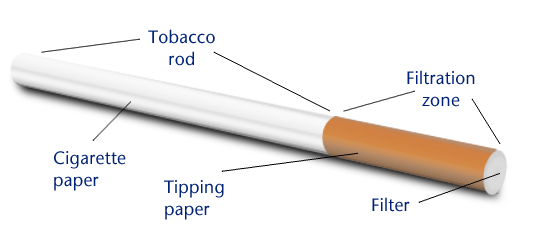Table of Contents (click to expand)
Cigarette companies spend a lot of money advertising to convince everyone that cigarettes are okay, but we now know that smoking ultimately leads to addiction and lung cancer. Filtered cigarettes were introduced in the 1950’s in an attempt to make cigarettes healthier, but they are just as harmful as unfiltered cigarettes. Filters are made of tiny fibers that get inhaled along with the smoke, and they actually encourage deeper drags, which result in more particles getting lodged in the lungs.
From the 1940’s right up until the 1980’s, the mainstream media (movies, TV shows, music videos) showed cigarette smoking in a positive light. There was even a time when multiple generations took up smoking solely because the actors in movies smoked like it was going out of style. It was considered to be the epitome of ‘cool’. Hugely popular movies like The Big Heat (1953) and Sunset Blvd (1950) portrayed excessive cigarette smoking as stylish and hip, which inspired teenagers and adults alike to take up smoking. Unfortunately, we now know that smoking ultimately leads to addiction.
Before the 1950’s, however, there was no such thing as a filter-tipped cigarette – or at least no one smoked them. People smoked unfiltered cigarettes without any consideration of the long-term health effects. At that time, there were increasing concerns that cigarettes might be harmful, but there was no proof. Cigarette companies also spent a lot of money advertising in order to convince everyone that cigarettes were okay.
That all changed in the 1950’s when a medical study came out with results that positively linked cigarette smoking to lung cancer. That was when filters in cigarettes were introduced.
What Is The Purpose Of These Filters And How Do They Work?

Nowadays, a cigarette filter is made from the same material that is used to make camera film, i.e., cellulose acetate (cellulose is the fibrous part of wood), whereas in the 1950’s, Kent (a cigarette brand) used asbestos as part of their filters. Asbestos is heat-proof and insoluble, but also forms extremely fine fibers and causes lung cancer when inhaled. In other words, that strategy at making cigarettes healthier was an utter failure.
The main purpose of filters is to reduce the nicotine and tar intake by the smoker, which they do accomplish, but there is much more to the story.
The tip of the cigarette through which the smoker takes a drag consists of tiny, invisible perforations in the filter. These perforations act as a semi-permeable membrane (boundary), allowing air and small particulate matter to pass through, while preventing larger parts of tar and nicotine from passing into the smoker’s mouth. As the smoke flows through the filter, quite a bit of air flows through the perforations and mixes in with the smoke. With each drag, the smoker receives more air than smoke, and therefore less tar and nicotine.

Also Read: Are There Any Safe Alternatives To Cigarettes?
But Here’s The Catch…
A filtered cigarette is not necessarily healthier than an unfiltered variant because a seasoned smoker needs his daily dose of nicotine. An unfiltered cigarette will provide the smoker with the nicotine in its full capacity, whereas a filtered one will eliminate most of the addictive particles. Therefore, the person will feel the urge to smoke until he gets his full dose for that particular period. Essentially, he will end up smoking more cigarettes to get the same fix.
Here’s why filtered cigarettes are potentially just as harmful as unfiltered ones – if not more!
Each filter is made up of tiny little fibers that get inhaled along with the smoke. Due to filters, however, smoke feels milder on the throat, which in turn encourages deeper drags. Although they block tar particles, smaller particles still travel into the lungs along with the smoke, which results in them becoming lodged even deeper in the lungs.
Smoking doesn’t seem so cool anymore, right?
Also Read: Why Do Cigarettes Burn Faster Than Cigars?
What Do Manufacturers Not Tell You?
Numerous studies have been conducted that reveal the fact that massive amounts of carbon particles are inhaled despite the presence of a filter; in fact, there are ‘too many’ to count. When the filter is cut, there are always loose strands left behind, which are inhaled along with the smoke particles that get sucked down into the lungs of each and every smoker.
So, next time you’re thinking about lighting up a smoke, don’t assume that you’re being healthier by smoking a filtered cigarette; you’re just playing into cigarette companies’ hands, buying more packs to get your fix, and still threatening your long-term health.
How well do you understand the article above!

